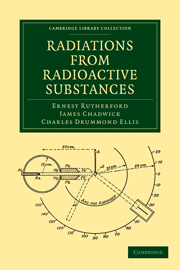Book contents
- Frontmatter
- Contents
- LIST OF PLATES
- Preface
- Chap. I Radioactive Transformations
- Chap. II The α Rays
- Chap. III Absorption of the α Rays
- Chap. IV Some Properties of the α Particle
- Chap. V Theories of Absorption of α Rays
- Chap. VI Secondary Effects produced by α Rays
- Chap. VII General Properties of the Radiations
- Chap. VIII The Scattering of α and β Particles
- Chap. IX The Collisions of α Particles with Light Atoms
- Chap. X The Artificial Disintegration of the Light Elements
- Chap. XI The Radioactive Nuclei
- Chap. XII β Ray and γ Ray Spectra
- Chap. XIII The Disintegration Electrons
- Chap. XIV The Passage of β Particles through Matter
- Chap. XV The Scattering and Absorption of γ Rays
- Chap. XVI Intensity Problems connected with the Emission of γ Rays
- Chap. XVII Atomic Nuclei
- Chap. XVIII Miscellaneous
- Appendix
- Subject Index
- Index of Names
- Plate section
Chap. VI - Secondary Effects produced by α Rays
Published online by Cambridge University Press: 07 September 2010
- Frontmatter
- Contents
- LIST OF PLATES
- Preface
- Chap. I Radioactive Transformations
- Chap. II The α Rays
- Chap. III Absorption of the α Rays
- Chap. IV Some Properties of the α Particle
- Chap. V Theories of Absorption of α Rays
- Chap. VI Secondary Effects produced by α Rays
- Chap. VII General Properties of the Radiations
- Chap. VIII The Scattering of α and β Particles
- Chap. IX The Collisions of α Particles with Light Atoms
- Chap. X The Artificial Disintegration of the Light Elements
- Chap. XI The Radioactive Nuclei
- Chap. XII β Ray and γ Ray Spectra
- Chap. XIII The Disintegration Electrons
- Chap. XIV The Passage of β Particles through Matter
- Chap. XV The Scattering and Absorption of γ Rays
- Chap. XVI Intensity Problems connected with the Emission of γ Rays
- Chap. XVII Atomic Nuclei
- Chap. XVIII Miscellaneous
- Appendix
- Subject Index
- Index of Names
- Plate section
Summary
In this chapter we shall discuss some of the secondary effects accompanying the emission of αparticles, including the emission of delta rays, the recoil accompanjdng the ejection of an α particle, the heating effect produced by the absorption of α particles, and the production of helium due to the accumulated α particles.
§ 29. Emission of delta rays. When a stream of α particles passes through a thin sheet of matter in a vacuum, a number of electrons are observed to be emitted from both sides of the plate. The energy of the great majority of these electrons is only a few volts, but the total number from each surface of the plate is of the order of 10 times the number of incident α particles. J. J. Thomson, who first studied this emission of electrons from a polonium plate, gave them the name of 8 (delta) rays. A large amount of work has been done to determine the factors involved in the liberation of these electrons, including the effect of velocity of the α particle, the nature of the bombarded material, the state of its surface, and the distribution with velocity of the escaping electrons. Before discussing these data, it is desirable to consider the origin of these electrons. It is clear that the escape of electrons, whether from a radioactive surface or a bombarded plate, is in a sense a secondary effect connected with the absorption of energy of the α rays in their passage through matter.
In fact, on modern views, the emission of δ rays is a necessary and inevitable consequence of the passage of α rays through matter.
- Type
- Chapter
- Information
- Radiations from Radioactive Substances , pp. 147 - 166Publisher: Cambridge University PressPrint publication year: 2010First published in: 1930

